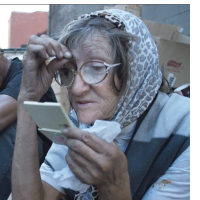The Graying of L.A.’s Skid Row Women
 Skid Row resident Lee Anne "Cat Lady" Leven. (photo: Cinema Libre Studio)
Skid Row resident Lee Anne "Cat Lady" Leven. (photo: Cinema Libre Studio)
Even as gentrification bumps up against L.A.’s Skid Row, the condition of its 10,000 or so occupants continues to decline in many ways.
A new report (pdf) from the Downtown Women’s Action Coalition DWAC) found women in the 50-block area are much older and, consequently, in poorer health than they were a decade ago. The group’s 2013 survey of 324 women found the median age had jumped from 44 to 50 since 2001.
Nearly 11% of the women were 62 or older, 39.1% were 51-61, 23.7% were 41-50, 17% were 31-40 and 9.2% were 30 of younger. Four women were over 70 and one topped 80.
In addition to being older, women on Skid Row are more likely to have high school degrees than their predecessors, more than 70% for the first time. About 7.6% have a college degree and 2.3% have completed post-graduate work. In 2007, 14% of the women had college degrees.
Part of the reason for the graying population was attributed to women staying on Skid Row for a longer period of time. More than 28% of women over the age of 51 reported they had been there for at least five years. But an older group of newcomers, 21.5% of those over the age of 51, has also made their mark. They have only been there for less than a year.
About a quarter of women survey in 2001 had been on the street for at least five years. That peaked at 40% in 2010 and was 32.6% in 2013. Eleven reported being homeless for at least 20 years.
Older women reported having more medical problems. Half of the women over 50 said they had fair or poor health compared to 30.3% of those younger. More than 65% said they had some form of disability. Women surveyed by the coalition overwhelmingly listed shelter as their No. 1 problem (73.1%). Around one in four said they had been sexually assaulted within the past year.
One segment of the Skid Row population that is expected to rise precipitously in the near future is veterans. Right now, around 2.2% of women identify as ex-military. But the growing number of women in the military, the end to stressful tours of duty in the Mideast and the late onset of post traumatic syndrome is expected to swell their ranks.
It is estimated that about 1,700 people on Skid Row sleep on the streets. But the total population of the neighborhood, including those in shelters and other housing, is variously estimated at between 7,000 and 10,000. About a quarter are said to be women.
The coalition report, which is a survey and needs assessment, said its numbers would have been worse if L.A. had not launched Project 50 in 2007. The program, aimed at helping the 50 most chronic, longtime homeless on Skid Row, had the immediate effect of reducing their hospitalization by 150 days and incarceration 600 days the first year.
The long-term effect is establishing in the public consciousness that homelessness is not an intractable problem generated by people who are beyond help. The survey indicates that Skid Row women would make use of health services, shelter, jobs and a safer environment, and the result could be a cost savings for the community at large. Project 50 saved taxpayers $550,000 in jail and medical costs the first year, the report said.
It is unclear if they will utilize additional trash cans. The county of Los Angeles is joining with the city’s 2-year-old Operation Healthy Streets to spruce up the area a bit with $3.7 million in funding. Sidewalks and streets will get washed down regularly and 10 trash cans will be deployed.
City Councilman Jose Huizar said at a recent press conference that the effort would also wrap in social and medical services, but his comments were met with skepticism by some homeless activists.
Pete White, co-executive director of Los Angeles Community Action Network, told the Los Angeles Daily News the money would have been better spent on restrooms than trash cans. “For us, for organizers and residents who attended this morning, it ran very hollow,” he said. “The promises were pretty much baseless.”
–Ken Broder
To Learn More:
A Growing Percentage of Women on Skid Row Are Older, Survey Finds (by Gale Holland, Los Angeles Times)
Los Angeles City and County Collaborate to Tackle Homelessness on Skid Row (by Susan Abram, Los Angeles Daily News)
2013 Downtown Women’s Needs Assessment (Downtown Women’s Action Coalition) (pdf)
- Top Stories
- Controversies
- Where is the Money Going?
- California and the Nation
- Appointments and Resignations
- Unusual News
- Latest News
- California Forbids U.S. Immigration Agents from Pretending to be Police
- California Lawmakers Urged to Strip “Self-Dealing” Tax Board of Its Duties
- Big Oil’s Grip on California
- Santa Cruz Police See Homeland Security Betrayal in Use of Gang Roundup as Cover for Immigration Raid
- Oil Companies Face Deadline to Stop Polluting California Groundwater





